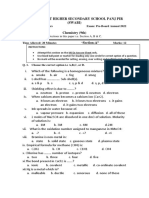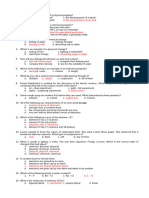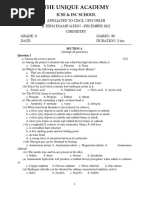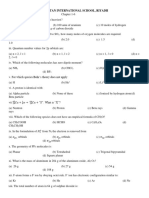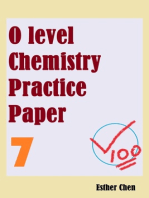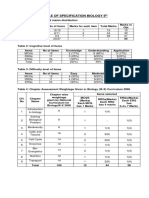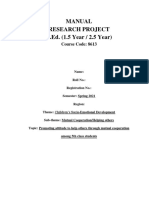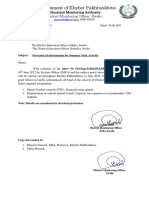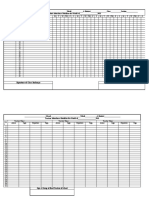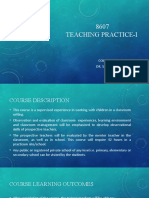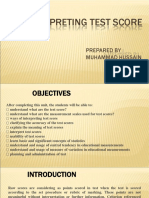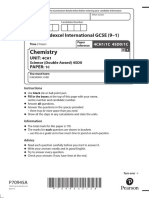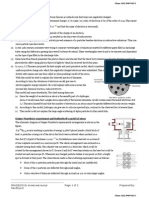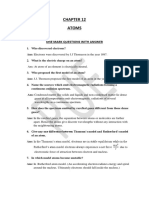0 ratings0% found this document useful (0 votes)
38 viewsChemistry 9
Chemistry 9
Uploaded by
Aamir HabibThis document contains 12 multiple choice questions covering topics in chemistry including:
1. Homogeneous mixtures
2. Electron configurations and subshells
3. Shielding effect and the particles responsible
4. Changes that occur when calcium forms an ion
5. Reasons for ink diffusion in water
6. Calculation of molarity from moles of solute and liters of solution
3 sentences or less is not sufficient to fully summarize the content of this document. It contains a variety of chemistry questions testing knowledge of fundamental concepts.
Copyright:
© All Rights Reserved
Available Formats
Download as DOCX, PDF, TXT or read online from Scribd
Chemistry 9
Chemistry 9
Uploaded by
Aamir Habib0 ratings0% found this document useful (0 votes)
38 views2 pagesThis document contains 12 multiple choice questions covering topics in chemistry including:
1. Homogeneous mixtures
2. Electron configurations and subshells
3. Shielding effect and the particles responsible
4. Changes that occur when calcium forms an ion
5. Reasons for ink diffusion in water
6. Calculation of molarity from moles of solute and liters of solution
3 sentences or less is not sufficient to fully summarize the content of this document. It contains a variety of chemistry questions testing knowledge of fundamental concepts.
Original Title
chemistry 9.docx
Copyright
© © All Rights Reserved
Available Formats
DOCX, PDF, TXT or read online from Scribd
Share this document
Did you find this document useful?
Is this content inappropriate?
This document contains 12 multiple choice questions covering topics in chemistry including:
1. Homogeneous mixtures
2. Electron configurations and subshells
3. Shielding effect and the particles responsible
4. Changes that occur when calcium forms an ion
5. Reasons for ink diffusion in water
6. Calculation of molarity from moles of solute and liters of solution
3 sentences or less is not sufficient to fully summarize the content of this document. It contains a variety of chemistry questions testing knowledge of fundamental concepts.
Copyright:
© All Rights Reserved
Available Formats
Download as DOCX, PDF, TXT or read online from Scribd
Download as docx, pdf, or txt
0 ratings0% found this document useful (0 votes)
38 views2 pagesChemistry 9
Chemistry 9
Uploaded by
Aamir HabibThis document contains 12 multiple choice questions covering topics in chemistry including:
1. Homogeneous mixtures
2. Electron configurations and subshells
3. Shielding effect and the particles responsible
4. Changes that occur when calcium forms an ion
5. Reasons for ink diffusion in water
6. Calculation of molarity from moles of solute and liters of solution
3 sentences or less is not sufficient to fully summarize the content of this document. It contains a variety of chemistry questions testing knowledge of fundamental concepts.
Copyright:
© All Rights Reserved
Available Formats
Download as DOCX, PDF, TXT or read online from Scribd
Download as docx, pdf, or txt
You are on page 1of 2
i. Which of the following is a homogeneous mixture?
a. smoke b. air c. fog d. smog
ii. L-shell has ……………. Sub-shell(s).
a. s & p b. s c. s, p & d d. s, p, d & f
iii. Shielding effect is due to ………?
a. neutron b. proton c. proton & neutron d. electron
iv. When calcium atom becomes a calcium ion (Ca+2).
a. It loses an electron b. it loses two electrons c. it gains an
electron d. it gains two electrons
v. Ink spreads in water because of.
a. vapour pressure b. expansion c. diffusion d. all of
these
vi. 2 moles of Na2SO4 are dissolved in one dm3 of solution. Molarity of solution
is:
a. 1M b. 3M c. 4M d.2M
vii. What is the oxidation number assigned to manganese in KMnO4:
a. -7 b. -6 c. +7 d. +6
viii. Bromine is non-metal in:
a. liquid state b. solid state c. gaseous state d. plasma state
ix. Empirical formula for methane (CH4) is:
a. C2H2 b. CH c. C1H1 d. CH4
x. Chlorine has ……… number of isotopes?
a. two b. three c. four d. five
xi. The bond present in CaCl2 is …….?
a. ionic b. covalent c. metallic d. co-ordinate covalent
xii. Hg is a metal which is?
a. malleable b. ductile c. sonorous d. none of these
Section-b
Q.2:
i. Cm is the chemical symbol for curium, named after the famous scientist
Madam Curie. Why were not the symbol C, Cu or Cr used instead?
ii. What is the reason that physical properties of the isotopes are different but
their chemical properties are the same?
iii. Which element of the group IA is not an alkali metal and why?
iv. What is electron-sea model of metallic bonding?
v. Explain why it happens that on a hot summer day when there is a sweat on the
body of a person, one feels cool under fast moving fan?
vi. Why we stir paints thoroughly before using?
vii. Sketch the Daniel cell, labeling the cathode, anode and the direction of flow
of the electrons.
viii. State the physical properties of metals.
40
ix. Write down the electronic configuration of 18 Ar .
x. Differentiate between atomic radii and covalent radii.
xi. Give an example of a non-polar molecule with polar bonds. Give reasons.
Section-c
Q.3:
1. Explain Rutherford’s model of atom in detail.
2. (a) give the classification of molecules in detail
(b) summarize Bohr’s atomic model.
3. (a) explain shielding effect.
(b) describe ionization energy in detail.
4. (a) what is the meaning of the term polar, as applied to chemical
bonding.
(b) explain Charles’ law in detail.
You might also like
- Physical Science Exam PDFDocument2 pagesPhysical Science Exam PDFRemar Jhon PaineNo ratings yet
- 6 Weeks Teaching Practice Completion Certificate For BDocument1 page6 Weeks Teaching Practice Completion Certificate For BAamir Habib100% (1)
- 9th Class Annual Chemistry Paper Group B New PDFDocument2 pages9th Class Annual Chemistry Paper Group B New PDFAamir HabibNo ratings yet
- Inbound 4545902604877984163Document6 pagesInbound 4545902604877984163Love PactoNo ratings yet
- PreboardELEMGeneral Education PreboardDocument6 pagesPreboardELEMGeneral Education PreboardJezha Mae Vertudazo0% (1)
- Britney Rodriguez, 10th Grade - Fall Final Review PAPDocument9 pagesBritney Rodriguez, 10th Grade - Fall Final Review PAPBritney RodriguezNo ratings yet
- Chemistry 9th Model PaperDocument3 pagesChemistry 9th Model PaperHasnain Ahmad KhanNo ratings yet
- Test Questions GR9Document3 pagesTest Questions GR9Irene Dela CruzNo ratings yet
- Quart 2 PT TOS 3Document6 pagesQuart 2 PT TOS 3Bryan Lebasnon100% (1)
- Chemistry - Exam Drill IDocument6 pagesChemistry - Exam Drill IJovenil BacatanNo ratings yet
- Chemistry - Exam Drill IDocument6 pagesChemistry - Exam Drill IJovenil BacatanNo ratings yet
- Second Periodical Test in Science 9Document2 pagesSecond Periodical Test in Science 9tolisNo ratings yet
- Goldengate Int'L College: First Terminal Examination-2080Document2 pagesGoldengate Int'L College: First Terminal Examination-2080sachin shahNo ratings yet
- Class 1st Chemistry Test Unit FullDocument5 pagesClass 1st Chemistry Test Unit FullAadNo ratings yet
- PS 1ST Quarter ExamDocument3 pagesPS 1ST Quarter ExamMary Grace Castro LaysonNo ratings yet
- SASECHEMDocument3 pagesSASECHEMH.Mohammad JohanyNo ratings yet
- 2ndpt (Chem)Document3 pages2ndpt (Chem)cresel.alcantaraNo ratings yet
- Practice Questions Part 1Document5 pagesPractice Questions Part 1Bierzo JomarNo ratings yet
- 10-PART I - MULTIPLE CHOICE (30 Multiple Choice Questions. Each Multiple Choice Question Is Worth 2 Points)Document7 pages10-PART I - MULTIPLE CHOICE (30 Multiple Choice Questions. Each Multiple Choice Question Is Worth 2 Points)Nesrine LaradjiNo ratings yet
- Cadaloria High School: Schools Division Office of IsabelaDocument3 pagesCadaloria High School: Schools Division Office of IsabelaRichwellPanganibanSolivenNo ratings yet
- Ocean Water Contains Mineral SaltsDocument3 pagesOcean Water Contains Mineral SaltsApril Joyce Ricamora NarcisoNo ratings yet
- Anees Chemical BondingDocument7 pagesAnees Chemical Bondingfa8068291No ratings yet
- Govt. Degree Girls College Block K North Nazimabad Section A (M.C.QS) Xii-ChemistryDocument5 pagesGovt. Degree Girls College Block K North Nazimabad Section A (M.C.QS) Xii-ChemistryImran UlhaqueqNo ratings yet
- Chemistry ReviewerDocument24 pagesChemistry Reviewerchristy janioNo ratings yet
- MCQUnit-IDocument16 pagesMCQUnit-Ipandharepratik991No ratings yet
- President'S Office Regional Administration and Local GovernmentDocument4 pagesPresident'S Office Regional Administration and Local GovernmentHashir SaidNo ratings yet
- President'S Office Regional Administration and Local GovernmentDocument4 pagesPresident'S Office Regional Administration and Local GovernmentHashir SaidNo ratings yet
- Chemistry 1Document4 pagesChemistry 1samwelaldoboyNo ratings yet
- ChemistryDocument3 pagesChemistryanaynoob55No ratings yet
- 2nd Quarter Exam For Science 9Document5 pages2nd Quarter Exam For Science 9Jocelyn MarmolNo ratings yet
- Bonding ..Q + MSDocument26 pagesBonding ..Q + MSSveta StepanovaNo ratings yet
- Science 9 Summative Test 2Document3 pagesScience 9 Summative Test 2Ma. Socorro Hilario50% (2)
- Periodical Exam in Physical ScienceDocument3 pagesPeriodical Exam in Physical Sciencejayson babaran100% (1)
- Final Test Chemistry 10Document5 pagesFinal Test Chemistry 10rohmatul aziziNo ratings yet
- Chem FM 3 Pre Tahossa - 20Document4 pagesChem FM 3 Pre Tahossa - 20Mycovich MycoNo ratings yet
- Second Grading Examination Science 9Document5 pagesSecond Grading Examination Science 9jtxbny100% (1)
- Matter and Chemical Change ReviewDocument4 pagesMatter and Chemical Change ReviewjacquelinebicekNo ratings yet
- summer 1st semester InorganicDocument2 pagessummer 1st semester InorganicJamshaid AliNo ratings yet
- CHM-2045 Exam 1 Sample QuestionsDocument7 pagesCHM-2045 Exam 1 Sample QuestionsFrankNo ratings yet
- Grade 10Document4 pagesGrade 10jbezos9000No ratings yet
- DPP - 2Document3 pagesDPP - 2ixh36.priyobirroyNo ratings yet
- ExamView - EASE 1 CHEMISTRY GRADE 10Document12 pagesExamView - EASE 1 CHEMISTRY GRADE 10Muhammad Awaludin NoorNo ratings yet
- Inbound 1234022357278411776Document8 pagesInbound 1234022357278411776Love PactoNo ratings yet
- Classification of Elements and Periodicity in Properties DPP 2Document2 pagesClassification of Elements and Periodicity in Properties DPP 2Agnish BiswasNo ratings yet
- Chemistry Paper 1 2009Document7 pagesChemistry Paper 1 2009Robert EdwardsNo ratings yet
- 2nd Periodical Examination in Sci g9Document4 pages2nd Periodical Examination in Sci g9george barnachea100% (7)
- Arusha ChemistryDocument6 pagesArusha ChemistryJohn shijaNo ratings yet
- JSE Chemistry FinalExam 2022Document18 pagesJSE Chemistry FinalExam 2022davisteohjiunnkhaiNo ratings yet
- Matching: Match Each Item With The Correct Statement BelowDocument16 pagesMatching: Match Each Item With The Correct Statement BelowwallaNo ratings yet
- CompoundsDocument2 pagesCompoundsChi StephNo ratings yet
- CQ On Chap-3 (Chemistry 1 Paper)Document4 pagesCQ On Chap-3 (Chemistry 1 Paper)Mahin AzizNo ratings yet
- Pisr Paper 1st Year 1-6Document3 pagesPisr Paper 1st Year 1-6SingularityNo ratings yet
- Pre Board Exam, 2020-21 Chemistry, (043) Theory Class - XIIDocument8 pagesPre Board Exam, 2020-21 Chemistry, (043) Theory Class - XIIKshreeNo ratings yet
- C3.periodic Properties MCQ Practice SolvedDocument3 pagesC3.periodic Properties MCQ Practice Solvednihonkhan.24No ratings yet
- Science Chapter Test - Atoms and MoleculesDocument5 pagesScience Chapter Test - Atoms and Moleculesjaiiaadityakannan96420No ratings yet
- SHREE POKHARIYA SECONDARY SCHOOL Class 11 Tech.Document2 pagesSHREE POKHARIYA SECONDARY SCHOOL Class 11 Tech.pakheyyyNo ratings yet
- 2nd-Unit TestDocument2 pages2nd-Unit TestCedric Tamares Evaristo100% (1)
- Sample Exam 3Document5 pagesSample Exam 3Sonia FelixNo ratings yet
- 9th Class Annual Chemistry Paper Group BDocument3 pages9th Class Annual Chemistry Paper Group BAamir HabibNo ratings yet
- WindScribe 30GB Reedem Code VoucherDocument1 pageWindScribe 30GB Reedem Code VoucherAamir Habib100% (1)
- DSTP2.0-Batch-04 ATC101 1Document3 pagesDSTP2.0-Batch-04 ATC101 1Aamir HabibNo ratings yet
- 6499 Lesson PlanDocument160 pages6499 Lesson PlanAamir HabibNo ratings yet
- Biology 9th Specs 1 PDFDocument1 pageBiology 9th Specs 1 PDFAamir HabibNo ratings yet
- PST Male SwabiDocument93 pagesPST Male SwabiAamir HabibNo ratings yet
- 3rd EnglishDocument2 pages3rd EnglishAamir HabibNo ratings yet
- Final Lesson PlansDocument10 pagesFinal Lesson PlansAamir HabibNo ratings yet
- Action PlanDocument2 pagesAction PlanAamir HabibNo ratings yet
- Promoting Attitude To Help Other Through Mutual Cooperation Among 5th Class StudentsDocument22 pagesPromoting Attitude To Help Other Through Mutual Cooperation Among 5th Class StudentsAamir HabibNo ratings yet
- 1263 Special Summer Task To DEO OfficesDocument1 page1263 Special Summer Task To DEO OfficesAamir HabibNo ratings yet
- UNIT-3 Intellectual DevelopmentDocument58 pagesUNIT-3 Intellectual DevelopmentAamir HabibNo ratings yet
- Professionalism in Teaching: Theory To Practice: Course Code: 8612 Unit 3Document20 pagesProfessionalism in Teaching: Theory To Practice: Course Code: 8612 Unit 3Aamir HabibNo ratings yet
- 40 Lesson PlansDocument109 pages40 Lesson PlansAamir HabibNo ratings yet
- Introduction of Profession and Concept of Teaching: Course Code: 8612 Unit 1Document19 pagesIntroduction of Profession and Concept of Teaching: Course Code: 8612 Unit 1Aamir HabibNo ratings yet
- Teaching Practice-I Student Teacher Responsibilities During Teaching Practice IDocument20 pagesTeaching Practice-I Student Teacher Responsibilities During Teaching Practice IAamir HabibNo ratings yet
- 8608 Attendance Record and Completion CertificateDocument3 pages8608 Attendance Record and Completion CertificateAamir HabibNo ratings yet
- Course Code 8610 Human Development and Learning Course Code 8610 Human Development and LearningDocument53 pagesCourse Code 8610 Human Development and Learning Course Code 8610 Human Development and LearningAamir HabibNo ratings yet
- 8607 Teaching Practice-I: Course Coordinator: Dr. Syed Nasir HussainDocument23 pages8607 Teaching Practice-I: Course Coordinator: Dr. Syed Nasir HussainAamir HabibNo ratings yet
- General Methods of Teaching: CODE NO. 8601 B.Ed Program Dr. Shaista Majid Assistant ProfessorDocument33 pagesGeneral Methods of Teaching: CODE NO. 8601 B.Ed Program Dr. Shaista Majid Assistant ProfessorAamir HabibNo ratings yet
- Signature of Class Incharge Sign & Stamp of Head Teacher of SchoolDocument2 pagesSignature of Class Incharge Sign & Stamp of Head Teacher of SchoolAamir HabibNo ratings yet
- Learning Science: Unit 4 BY Atika AbidDocument22 pagesLearning Science: Unit 4 BY Atika AbidAamir HabibNo ratings yet
- 8601 5 Activity Method by AhmedDocument32 pages8601 5 Activity Method by AhmedAamir HabibNo ratings yet
- Unit 7Document26 pagesUnit 7Aamir HabibNo ratings yet
- 8609 Philosophy of Education Assignment No.1Document19 pages8609 Philosophy of Education Assignment No.1Aamir HabibNo ratings yet
- Unit 7 Prepared By: Atika AbidDocument27 pagesUnit 7 Prepared By: Atika AbidAamir HabibNo ratings yet
- Unit 8..8602 PDFDocument47 pagesUnit 8..8602 PDFAamir HabibNo ratings yet
- Teaching of Science Concepts: Unit 9 Prepared: ATIKA ABIDDocument24 pagesTeaching of Science Concepts: Unit 9 Prepared: ATIKA ABIDAamir HabibNo ratings yet
- Modern Theory of SolidsDocument15 pagesModern Theory of Solidsadritanke1314No ratings yet
- LeadDocument3 pagesLeadKevinNo ratings yet
- Chapter 3 - (Molecular Geometry and Bonding Theory-Not MO)Document45 pagesChapter 3 - (Molecular Geometry and Bonding Theory-Not MO)PHƯƠNG ĐẶNG YẾNNo ratings yet
- (08.03.2021) - OBJ - XII - INT - REV - P - Modern pHYDocument17 pages(08.03.2021) - OBJ - XII - INT - REV - P - Modern pHYAbhinav SMNo ratings yet
- 10 - CharacterizationDocument16 pages10 - CharacterizationGuru P MNo ratings yet
- Science g8 ReviewerDocument14 pagesScience g8 ReviewerGianni Micha E. AnsaldoNo ratings yet
- 2-Ch2 (Atom and Element)Document46 pages2-Ch2 (Atom and Element)Mia YukimuraNo ratings yet
- Periodic Table WorksheetDocument3 pagesPeriodic Table WorksheetAri A Siddiqui100% (4)
- Chapter 22 - Physics - Coordinated Science - IGCSE CambridgeDocument154 pagesChapter 22 - Physics - Coordinated Science - IGCSE CambridgeAlvin DuaneNo ratings yet
- PH110 2010 08Document3 pagesPH110 2010 08lyon juniorNo ratings yet
- Focused Ion Beam (FIB) Combined With Scanning Electron Microscope (SEM)Document2 pagesFocused Ion Beam (FIB) Combined With Scanning Electron Microscope (SEM)jinmanNo ratings yet
- Inductively Coupled Plasma Chapter 1 PDFDocument5 pagesInductively Coupled Plasma Chapter 1 PDFKike Married RosemaryNo ratings yet
- Atoms and The Atomic TheoryDocument37 pagesAtoms and The Atomic TheorySupasinee RNo ratings yet
- 2.1 Composition of Matter: Chapter 2: Chemistry of LifeDocument15 pages2.1 Composition of Matter: Chapter 2: Chemistry of Lifeapi-520057338No ratings yet
- Electron Spin Resonance Spectroscopy: Calculating The Land e G-Factor For A Free ElectronDocument5 pagesElectron Spin Resonance Spectroscopy: Calculating The Land e G-Factor For A Free ElectronRahul DevarakondaNo ratings yet
- 4CH1 1C Que 2022Document28 pages4CH1 1C Que 2022mostafa barakatNo ratings yet
- Atoms and NucleiDocument2 pagesAtoms and NucleiSandhya80% (5)
- Organic Structures From Spectra 1 511 (1) 2 9Document8 pagesOrganic Structures From Spectra 1 511 (1) 2 9Artemis GomezNo ratings yet
- Day-5 ChemistryDocument2 pagesDay-5 ChemistryManushree NayakNo ratings yet
- Interpreting Successive Ionisation EnergiesDocument18 pagesInterpreting Successive Ionisation EnergiesMuyatwa LiksNo ratings yet
- VASP计算细节Document14 pagesVASP计算细节Nostalgia BlueNo ratings yet
- 7e S Electronic Structure of MatterDocument5 pages7e S Electronic Structure of Matterellainedelacruz0227No ratings yet
- Unit I Nuclear Structure & RadioactivityDocument66 pagesUnit I Nuclear Structure & RadioactivityAnupriya AnuNo ratings yet
- AP NotesDocument16 pagesAP Notes5A2 ChaitraNo ratings yet
- Walsh DiagramDocument9 pagesWalsh Diagramanamika67% (3)
- Science 9 Quarter 2 Week 1Document5 pagesScience 9 Quarter 2 Week 1Leslie Darwin DumasNo ratings yet
- Atoms: One Mark Questions With AnswerDocument13 pagesAtoms: One Mark Questions With AnswerPratheek KrishnaNo ratings yet
- Direct Nuclear Reactions and Compound Nucleus ReactionsDocument5 pagesDirect Nuclear Reactions and Compound Nucleus ReactionsKishore GujjarNo ratings yet
- Photoluminescence Spectroscopy and Its Applications 2Document11 pagesPhotoluminescence Spectroscopy and Its Applications 2Rohith100% (2)
- Lecture note_02Document9 pagesLecture note_02himanshugupta24.2.pNo ratings yet


